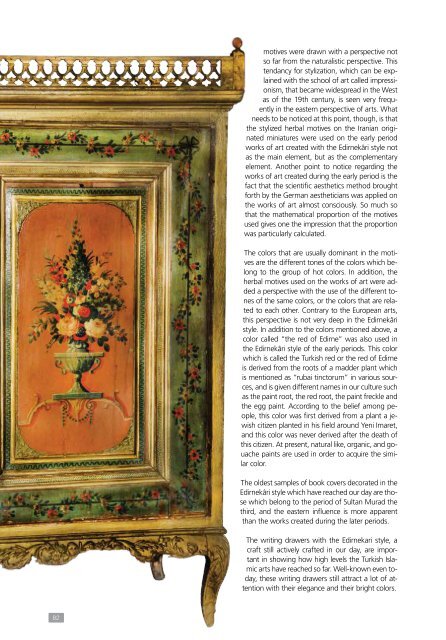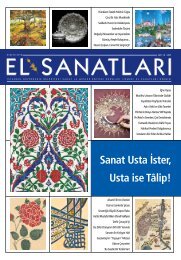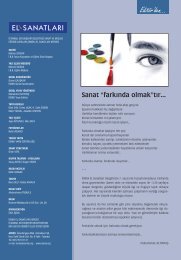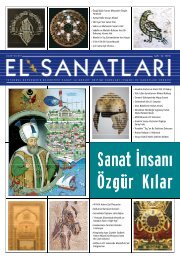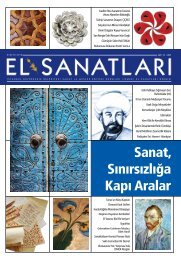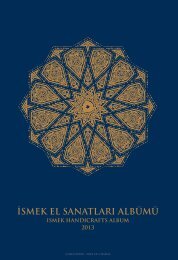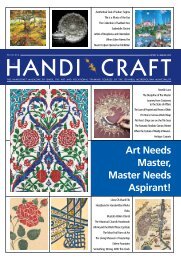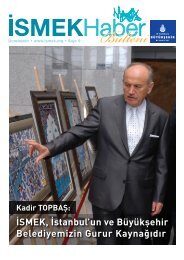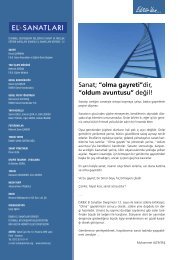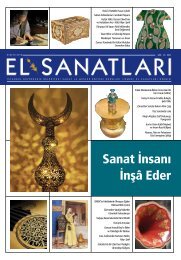motives were drawn with a perspective notso far from the naturalistic perspective. Thistendancy for stylization, which can be explainedwith the school of art called impressionism,that became widespread in the Westas of the 19th century, is seen very frequentlyin the eastern perspective of arts. Whatneeds to be noticed at this point, though, is thatthe stylized herbal motives on the Iranian originatedminiatures were used on the early periodworks of art created with the Edirnekâri style notas the main element, but as the complementaryelement. Another point to notice regarding theworks of art created during the early period is thefact that the scientific aesthetics method broughtforth by the German aestheticians was applied onthe works of art almost consciously. So much sothat the mathematical proportion of the motivesused gives one the impression that the proportionwas particularly calculated.The colors that are usually dominant in the motivesare the different tones of the colors which belongto the group of hot colors. In addition, theherbal motives used on the works of art were addeda perspective with the use of the different tonesof the same colors, or the colors that are relatedto each other. Contrary to the European arts,this perspective is not very deep in the Edirnekâristyle. In addition to the colors mentioned above, acolor called “the red of Edirne” was also used inthe Edirnekâri style of the early periods. This colorwhich is called the Turkish red or the red of Edirneis derived from the roots of a madder plant whichis mentioned as “rubai tinctorum” in various sources,and is given different names in our culture suchas the paint root, the red root, the paint freckle andthe egg paint. According to the belief among people,this color was first derived from a plant a jewishcitizen planted in his field around Yeni Imaret,and this color was never derived after the death ofthis citizen. At present, natural like, organic, and gouachepaints are used in order to acquire the similarcolor.The oldest samples of book covers decorated in theEdirnekâri style which have reached our day are thosewhich belong to the period of Sultan Murad thethird, and the eastern influence is more apparentthan the works created during the later periods.The writing drawers with the Edirnekari style, acraft still actively crafted in our day, are importantin showing how high levels the Turkish Islamicarts have reached so far. Well-known even today,these writing drawers still attract a lot of attentionwith their elegance and their bright colors.82
The ceiling decorations, corner cabinets and window frames onwhich the Edirnekari style is applied, unfortunately can not be compatibleto the concrete architecture of our day. Due to the fact thatit is costly, and that the buildings are not wooden anymore, theEdirnekâri style is not used in home decoration these days. Chestsand drawers used in homes, however, are still being crafted by thecraftsmen of this style.As for the decoration done with paint, they are worked on witha delicate style, and satihs and corners have been decorated differently,sometimes with fairly complicated compositions. Drawersbear a great artistic value.By exporting the most beautiful drawers of their age, Edirne quite rightfullyhad a reputation that spread in a wide area. Inside the drawers are specialsections for writing utensils such as paper, hokka set, scissors, and makta.Edirnekâri was Influenced by Baroque, tooAs of the 17th century, almost all the branches of the Turkish Islamic arts hadpositive or negative affects from the schools of art that were popular in Europe.It is thus impossible that edirnekâri too would be somewhat influenced. The Cand S curves of the Baroque style which was quite widespread in Europe during the17th century, for instance, were used in the decoration of wooden objects, but not ofthe book covers. In addition to the baroque influence obviously seen in the decorationsof the azan reciter lodge at the Selimiye Mosque of Edirne, the herbal motivesapplied with a naturalistic perspective were used in order to associate the audiencewith the arabesque style. As can be assumed from the motives here, theChinese and Persian influence on the early period works of art created with theedirnekâri style gradually decreases by the 17th century.Josef Maria Ritz, the writer of the book called Alte bemalte Bauernmobel which waspublished in 1962, gives detailed information about a certain wood carving art which isalso called the peasant origin art of furniture. The fact that some photographs the bookcontains have a style which is very similar to the Edirnekari style is fairly noteworthy. Themost distinct common characteristics of the Bauernmobel and the Edirnekâri styles are the baroquedescription of the bodies of the stylized herbal motives, the use of lake varnishing, avoidancefrom geometrical elements, and the very frequent use of the life tree. It is our hope that thesimilarity between these works will be thoroughly explored by researchers as soon as possible, and thatdetailed explanations will be made to the lovers of this art.Dr. Rifat Osman Tosyavizade states that he saw many samples of Edirnekâri signedby Safai, a bookbinder of Edirne, Dervish Safai, and Nazuhzade Kalenderoglu,in the UK, the USA, and Germany. Unfortunately, there is little researchdone regarding this rare decoration style of ours. Neither the book called “theTurkish Arts” by Oktay Aslanapa, nor the one with the same name by CelalEsad Arseven give any single information on Edirnekâri. The most comprehensiveresearch done on Edirnekâri is a dissertation called an Essay on Edirnakâri,prepared in 1984 by Hakan Tezcan. Except for this dissertation, the article calledThe Tulip works in the Turkish Art history and Their Craftsmen, written byOrd. Prof. Suheyl Unver in 1965, and published in the Magazine of Waqfs in thesame year, as well as the article called The Civilization of Edirne and the Samplesfrom the Decorative arts written by the same reasarcher in 1965, are noteworthyresearches done regarding this subject. In addition to all these, the articlecalled The Edirnekâri Style Wood Carvings in the Edirne Museum written bySabahattin Turkoglu, though has a local field of research, can still be consideredas one of the most important works regarding this subject.83
- Page 1:
Art Leads Oneto Eternity!
- Page 4 and 5:
In ThisEdition1506The StringentMast
- Page 6:
Dear Istanbulians,After the industr
- Page 10 and 11:
One Marbler Has Carried This Colorf
- Page 12 and 13:
this art”. Being single those day
- Page 14 and 15:
in flower marbling.” He says, and
- Page 16 and 17:
Cicek Derman: The DoyenneFlower of
- Page 18 and 19:
and does not want her to either stu
- Page 20 and 21:
der the very inside of you.” She
- Page 22 and 23:
ate” at all. The creator is one,
- Page 25 and 26:
Kundekâri:The Time Defying Heritag
- Page 27:
Cracks and incisions which could oc
- Page 30 and 31:
land to understand weather he can p
- Page 32 and 33:
When Deep WavesWash Ashore!by A. Ul
- Page 34 and 35: 'Bismillah' by Omer Faruk Deretaste
- Page 36 and 37: 'The Asr Surah' by Mustafa Cemil Ef
- Page 38 and 39: Van Gogh,The Genious Painter of Yel
- Page 40 and 41: and anxieties that surrounded him s
- Page 42 and 43: The most prominent features which w
- Page 44 and 45: Starry Night Over the Rhonehe opted
- Page 46 and 47: the left side of his face is a colo
- Page 48 and 49: The Threaded Version of Silver isRe
- Page 50 and 51: out from a narrower hole. Theseoper
- Page 52 and 53: Sumi-e: The Elegance which Comesint
- Page 54 and 55: traditions, perform this art seated
- Page 56 and 57: sumed in half an hour after it is p
- Page 59 and 60: er in ISMEK, after her illumination
- Page 61 and 62: 59Illustration: Hatice Ozturk
- Page 63 and 64: there was a captures chamberlain. 5
- Page 65 and 66: lack sides. As far as I can see del
- Page 67 and 68: One of the founders of the civilisa
- Page 69 and 70: The miniature by Ochiai Yoshiiku da
- Page 71 and 72: Miniatures are in the Irony of West
- Page 73 and 74: pictions of various countries, coul
- Page 75 and 76: A miniature example from the work n
- Page 77 and 78: “Ve mâ rameyte iz rameyte ve lak
- Page 79 and 80: usually there is a part consisting
- Page 81 and 82: When applied on wood, Edirnekâri c
- Page 83: What is very distinct regardingthe
- Page 87 and 88: There is an epigram for the Artof C
- Page 89 and 90: If the paper had spoken and told wh
- Page 91 and 92: nailing, gluing or compressing of t
- Page 93 and 94: gold. The notebooks with gold leave
- Page 95 and 96: laminary and get the required thick
- Page 97 and 98: Both the insufficience of green fie
- Page 100 and 101: 15 years ago, Mr. Yesilce allocated
- Page 102 and 103: On the Zoomorphic1Originsof the Rum
- Page 104 and 105: Shape-6Shape-13another finding foun
- Page 106 and 107: The Harem in the Topkapi Palace,The
- Page 108 and 109: very much like the school of boys i
- Page 110 and 111: The Blue Doors of TunisiaThe Articl
- Page 112 and 113: Tunisia is the pearl of the Mediter
- Page 114 and 115: Ottoman CultureProducts from Qadi R
- Page 116 and 117: An Overview of Written Sourcesin Ot
- Page 118 and 119: Signature of Abdulhamit II on the c
- Page 120 and 121: Pieces of Wastepapers TurnInto Jewe
- Page 122 and 123: in a short time, we ask him to make
- Page 124 and 125: Symbols of theLife of Thoughtby Pro
- Page 126 and 127: The Gulpayegan Masjid Kufi writing
- Page 128 and 129: which show some of the monumental w
- Page 130 and 131: An appearance from the interior of
- Page 132 and 133: The Kufic script at the top is prep
- Page 134 and 135:
in yerinize grafologla konusuverir.
- Page 136 and 137:
considered as a hard science rather
- Page 138 and 139:
Zeynep Bornovali states that differ
- Page 140 and 141:
The Dance of the Needle with Cerami
- Page 142 and 143:
was not the case, however, for the
- Page 144 and 145:
an area determined on the material
- Page 146 and 147:
Dilek Hanif: A Fashion DesignerWho
- Page 148 and 149:
others prefer to have a single and
- Page 150 and 151:
Princess Nazli:The Patron of Arts a
- Page 152 and 153:
which was also known as “Villa He
- Page 154 and 155:
A Bouquet From the Hidden Paradiseb
- Page 156 and 157:
Canfeza (Heart touching) A fully st
- Page 158 and 159:
“Someone whom I hadn’t met befo
- Page 160 and 161:
The Storm of ISMEK Blowingin the In
- Page 162:
Menaf Nam's work which was awarded


